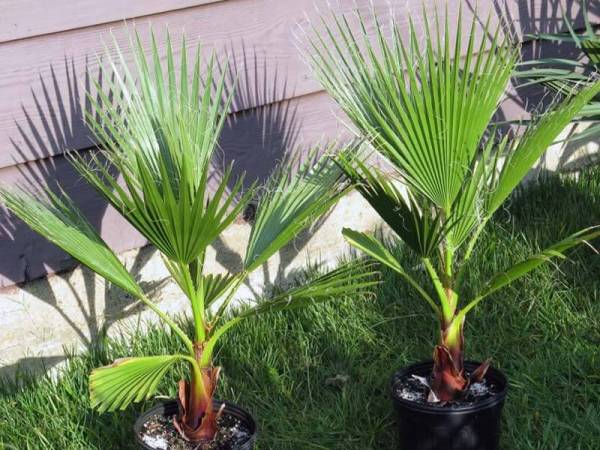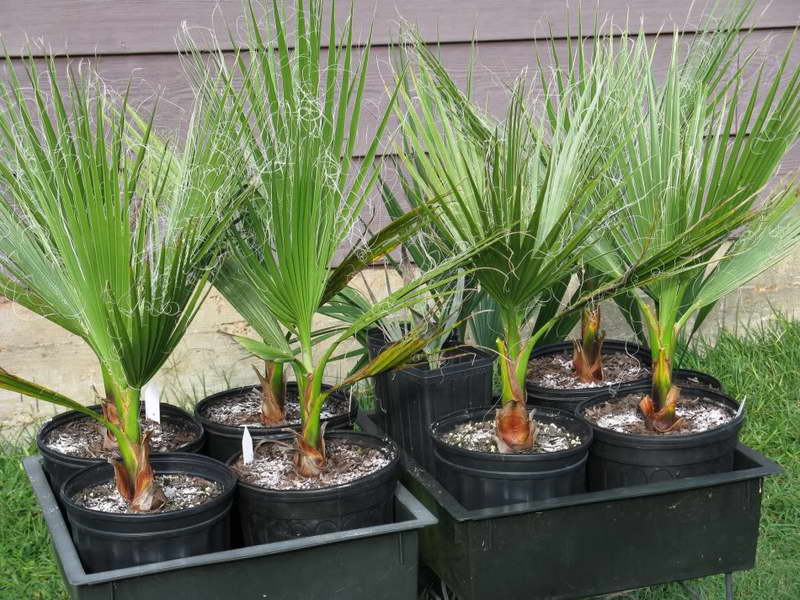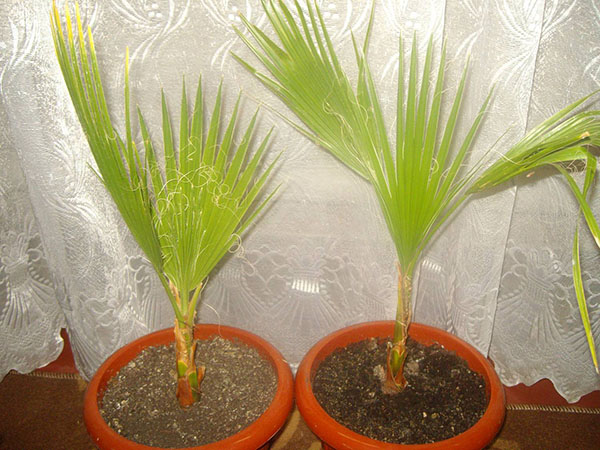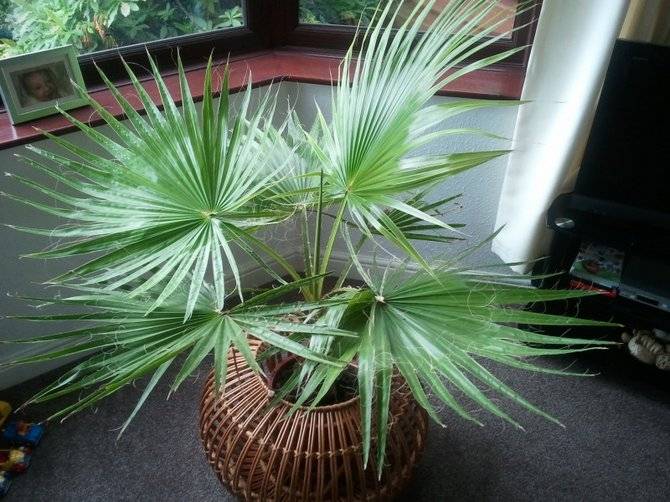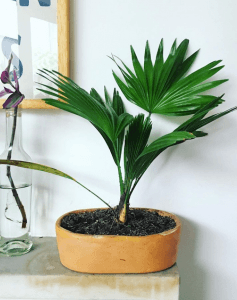Planting a washington palm tree
Tall pots will be needed for mature plants, but they are not necessary for young palms. In Washingtonia, fibrous roots are poorly developed, and the main root develops very long and makes several turns inside the pot. Its main mass is concentrated below, at the drainage layer
Over time, this root lignifies and, with careless handling of the root system during transplantation, easily breaks down and dies
Like most domestic palms, representatives of this genus perceive transplanting as painful. Their owners try to resort to radical intervention in the root system only in very extreme cases - if there is a suspicion of disease or pest damage.
Young seedlings are transplanted in the spring as they develop, middle-aged plants - every 2-3 years. Large-sized growers growing in tubs change only the top layer of an earthen coma 5-10 cm thick
Loosen it carefully with a wooden stick so as not to touch the roots, remove it with a palm in a rubber glove and fill in a new substrate
Very often, in the area of the root collar, the root system is exposed, which indicates that the pot for the palm tree has become cramped. However, you can take your time with the transfer work if the time is not right for them. It is enough to mulch the bare roots with wet sphagnum, and then during watering, after the moss has dried, raise it, watering only the substrate between the roots, and leaving the sphagnum dry.
Florists who bought Washingtonia in a flower shop often ask - should they replant the plant immediately after purchase? It is desirable, since in the pots with which the plant is sold, there is a large proportion of peat, and in it the palm tree feels uncomfortable.
A commercial soil mixture for growing Washingtonia is quite suitable for the purchased "For Palms", but it is quite possible to compose it yourself. It is enough to take 2 parts of sod soil and 1 part each of humus, peat, leafy earth and sand. For very large specimens, the amount of the sod component is doubled. A good drainage layer at the bottom is also important, consisting, as a rule, of expanded clay with the addition of a small amount of pieces of birch coal.

Total information
The plant got its name from the name of the first President of the United States, George Washington, but mostly it is used only by specialists - botanists. For the rest of the world's population, this is an ordinary palm tree growing in warm countries. Only two species belong to the genus Washingtonia: Washingtonia is powerful and Washingtonia is filamentous, which differ from each other in different shades of leaf stalks. In Washington, powerful, they are brown, and in filamentous, they are gray-green.
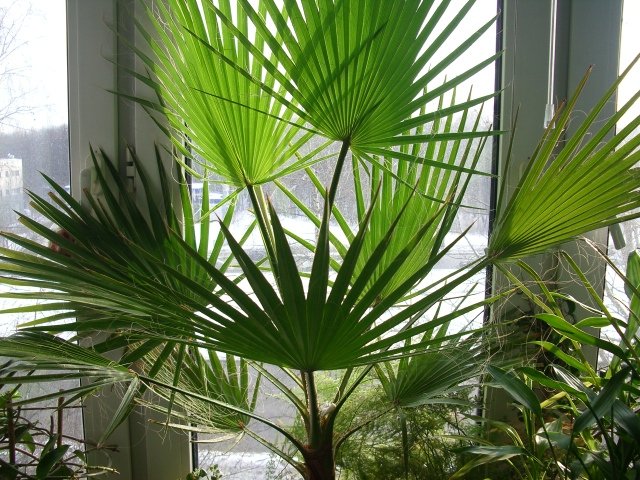
Washingtonia is thread-carrying.
Washingtonia filamentary is a tree that grows up to 15-20 meters in natural conditions. The trunk is round, cylindrical, up to 1 meter in diameter at the bottom, gradually tapering upward. The petioles of the fallen leaves remain on the trunk, forming strong, hard scales. The Washingtonia indoor palm tree does not grow more than 2-3 meters in height.
The leaves of the palm are fan-shaped, up to 4 meters long, green or gray-green in color, the leaf plate is cut into 1/3, into 80-90 segments. In the middle, the segments are long - up to one and a half meters, along the edges - up to 60-80 cm. At the edges of the leaves there are thin, twisted white threads, because of which the palm is called filamentous or thread-bearing.
Cuttings of leaves are the same length as leaf plates, in the lower part they have sharp thorns bent towards the trunk. During the season, a palm tree grows 12-13 leaves, which live for 3-4 years, and then fall off.
The filamentous palm tree blooms with paniculate inflorescences up to 5 cm long, with white, bisexual flowers.After the flowers, the fruit is formed in the form of an oblong drupe 1 cm long. Drupe is black or dark brown in color, shiny, the seeds inside are small, oval.
Popular varieties and types of exotic palm trees

Usually in our apartments you can find two of the most popular types of indoor palm trees.
Washingtonia filamentous (filamentous)
Its homeland is California, so the plant has another name - the California fan palm. In places of natural growth, it creates whole forests. The leaves of a tree of this species have a gray-green hue and a lot of the finest white threads. For a comfortable wintering of the filamentous washingtonia, it is necessary to provide an air temperature of 6-15 ° C plus a well-lit place.
Washingtonia robusta (powerful)
The tree was born on the shores of Mexico, so it is not surprising that it is also called the Mexican palm. Mature plants have a taller trunk than their Californian cousins and can grow up to thirty meters in height. The foliage of washingtonia has a powerful rich green color, but without snow-white threads. The leaf stalks have thorns, and the crown itself is at the top of the trunk and looks very compact. Wintering of this species does not require special conditions and can be carried out in the usual room mode for the owners.
Common problems with growing indoor palms
When keeping palm plants indoors, you can sometimes encounter a number of difficulties and problems:
- Decay of roots and trunk. The reason for this phenomenon is a strong waterlogging of the soil in combination with low temperatures. Treatment is possible only in the early stages, by transplanting with pruning of decayed areas of the root system. If rot has gone to the trunk, treatment is futile.
- Penicillosis. A fungal infection that infects young, growing leaves and then invades the growing point. It develops with a lack of light, low temperatures and water ingress on the apical kidney. Treatment in the early stages - by treatment with a systemic fungicide. Spraying with Ridomil Gold can be applied.
- Infectious spots. They appear as red-brown or yellow spots on the leaves. They are treated with fungicidal preparations (Topsin, Ridomil Gold).
- Brown leaves. The process caused by waterlogging of the soil, irrigation with cold water. The plant is dried or transplanted into a less water-absorbing substrate. Affected leaves are allowed to dry and trimmed over a dry cloth.
- Sunburn. Appears on the leaves of shade-tolerant palm species when placed in bright sun. Depending on the degree of damage, the leaves can retain their function or completely lose it. A top burn is especially dangerous, which leads to the complete death of the plant.
Pests on palms rarely settle, but sometimes you can encounter an infection with a mealybug, spider mite, thrips or scale insects. Treatment is carried out only with special chemical insecticides and acaricides.
To prevent diseases of palm plants, it is important to comply with the recommended growing conditions. Infectious and other lesions develop on specimens with weak immunity, which are contained incorrectly, in violation of agricultural technology
Features and appearance
Belongs to the palm family. Natural area of growth - Western Mexico and the southern part of the United States. In natural conditions, it grows up to 30 meters. The name was given in honor of the first president of America. Recently grown as a houseplant. Florists appreciate it for its high decorative effect.
The peculiarity of the palm tree is cold resistance. In winter, she feels great at 5-10 ° C on a glassed-in balcony. In regions with a mild climate, it can be planted in open ground. She is not afraid of light frosts down to -5 ° C. Young palms are kept in the premises. With age, they become too large and partially lose their decorative effect.
It looks interesting. The thin, rough trunk is covered with the remains of the petioles of fallen leaves.The leaves are large, symmetrical, resembling an open fan. Consist of segments. A kind of threads are formed between the segments. The petioles are long, with hard spines.
The lower leaves gradually dry out, but do not fall off. They go down, forming a skirt at the bottom of the trunk. In cultivation, dried leaves are cut to maintain the decorative effect of the plant.
Some interesting facts! One of the varieties of Washingtonia is edible. In the homeland of the plant, locals eat juicy petioles raw or boiled. The seeds are used to make flour. Leaves are also used - they are used to obtain fibers for weaving baskets.
Types of livistons with photos and names
Below will be described those types of Liviston palm, which are most often grown by flower growers at home.
Chinese Livistona (Livistona chinensis)

The palm tree reaches a height of 10 to 12 meters, and its trunk diameter is 0.4–0.5 meters. She is originally from South China. The surface of the upper part of the trunk is covered with remnants of dead leaf stalks and fibers. And the bottom of the barrel has a jagged surface. The fan-shaped drooping leaf plates include from 50 to 80 folded segments, which are deeply incised at the tips. The leaves have wide petioles, the length of which can be up to 150 cm, on their lower surface there are many straight, short and rather sharp thorns. The length of the axillary inflorescence often exceeds 100 cm.
Livistona rotundifolia

Or liviston rotundifolia. In nature, this species can be found on the coastal sandy soils of the Moluccas and Java. The height of the trunk is up to 14 meters, and in diameter it reaches about 17 centimeters. Green glossy fan-shaped leaf plates of a rounded shape reach about 150 cm in diameter, and they are dissected into folded segments by 2/3 of their length. The foliage has long (up to 150 cm) petioles, which are densely covered with thorns in the lower 1/3 of the part. The length of the axillary inflorescence is about 150 cm, it consists of yellow flowers. Since this species is most popular with flower growers, this article described how to care for it.
Livistona australis

This species is native to the subtropical humid forests of eastern Australia. The height of the columnar trunk of this palm is about 25 meters, while it reaches up to 0.4 m in diameter. At the base, the trunk is thickened and its surface is covered with scars, as well as the remnants of sheaths of leaf plates. Folded radially fanned leaves are divided into small lobes with double-cut ends. These glossy dark green leaf plates have long (about 200 cm) petioles, along the edges of which are densely located sharp thorns, painted almost brown. The length of the branched axillary inflorescence is about 1.3 m.
Livistona decipiens

This single-stemmed palm tree is slow growing, and it reaches a height of about 12 meters, a trunk diameter of up to 25 centimeters. The leaf plates are fan-shaped; they are dissected into drooping segments in numerous veins. Their front surface is dark green, and the wrong side is grayish-waxy. The leaf petioles have many small teeth.
Livistona mariae
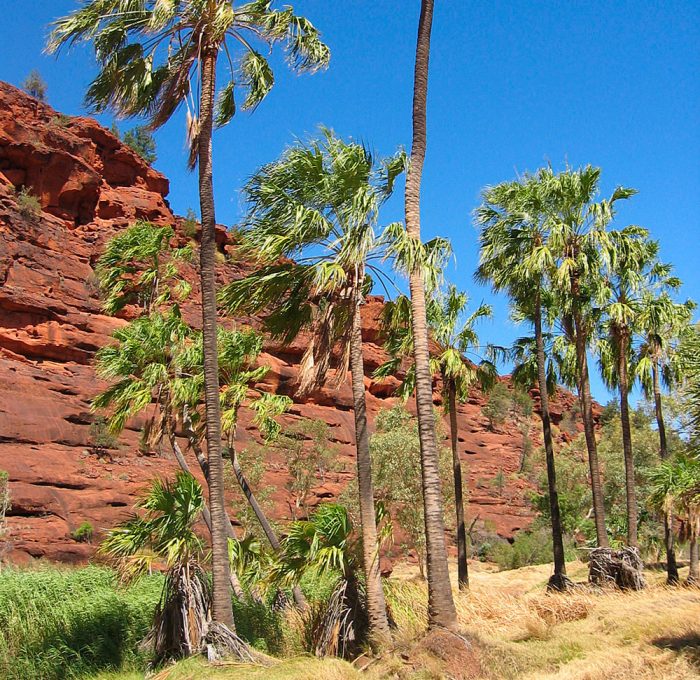
Under natural conditions, this large palm tree can reach a height of about 30 meters. At the base, the gray trunk has a thickening, and its surface is covered with the remnants of leaf sheaths. The length of the fan-shaped leaf plates, like their petioles, is about 200 centimeters, they are divided into drooping lobes of a linear shape, and at a young age they have a reddish-pink color. As the lobes grow and develop, they turn reddish-bronze, and eventually become green-blue. Simple panicles consist of cream or yellowish flowers. Glossy fruits of a spherical shape are colored black, they reach about 20 mm in diameter.
In addition to the species described above, Easton Liviston is also grown at home, beautiful and other species that are still poorly understood today.
How to grow Liviston
3. Varieties:
3.1 Washingtonia filifera - Washingtonia filifera
Slender elegant palms up to 15 m high. The trunks of the trees are thick, powerful, bearing the remains of old fallen leaves. The leaves are compound, fan-shaped, reaching a length of 4 m. The leaf stalks grow up to 2 m, in adult plants they have curved thorns. The leaf segments are glossy, dark green, reaching a length of 100 - 120 cm. A distinctive feature of this plant is the presence of thin light fibers on the leaves. In the natural environment, in the warm season, the plant forms large, penetrating inflorescences with small, yellowish flowers. After flowering, the flowers turn into small rounded berries up to 1 cm in diameter. In room culture, flowering rarely occurs.

3.2 Washingtonia robusta or powerful - Washingtonia robusta
Tall slender palms reaching 30 m in height. The trunks are single, gray, with the remains of fallen leaves. In their natural habitat, dried leaf blades often remain under the lush green crown. Leaves are complex, fan-shaped, reaching a diameter of one and a half meters, consist of numerous narrow, linear, glossy segments. The leaf stalks grow up to 1 m in length and have sharp thorns along the edge. Large, branched, drooping inflorescences grow up to 3 m and bear numerous small orange or yellow flowers. As they ripen, the flowers turn into rounded black berries up to 8 mm in diameter.

You may also be interested in:
Varieties of palm trees
Washingtonia has several varieties that differ not only in external features, but also in the nuances of growing at home. The most common types of plants are:
- Washingtonia is filamentous (filamentous). In nature, it became widespread in the south of North America. Medium specimens grow up to 20–22 m in height and up to 6 m in diameter. The foliage of the filamentous palm is light green with white veins. Its fruits are edible. This palm tree prefers a cool temperature of 5-15 ° C in winter, so it is rarely grown at home.
- Washingtonia Robusta (Santa Barbara). A taller species with edible seeds. It is used more often as a houseplant, since it has a weaker frost resistance.
Washingtonia powerful (aka Robusta) is a frequent guest among indoor plants. This option is ideal both for landscaping offices or shopping centers, and for residential buildings. If you provide proper care for such a plant, then it can grow in just a few years.

Robusta is ideal for landscaping offices, shopping centers and residential buildings
Home care
Washingtonia cannot be attributed to unpretentious plants. She is suitable for those who can pay enough attention and properly care for her.
Illumination

Washingtonia is a light-loving plant
In winter, supplementary lighting is provided to the plant using special ultraviolet lamps. In summer, the plant feels good in the fresh air, in a well-lit place, but without exposure to direct sunlight.
Temperature regime
The plant does not like too much heat. If in the room where the palm tree stands, the temperature is more than 30 ℃, then transfer it to a cooler room. The optimum temperature for summer is 20-25 ℃. In winter, the room temperature should be 10-12 ℃. At this time, Washington has a dormant period, new leaves do not develop, so do not worry that low temperatures will somehow harm the plant.
The palm tree is able to withstand subzero temperatures, but you should not artificially create such harsh conditions.
Watering
Like many plants, Washingtonia does not tolerate both drying out of the soil and its overflow. Monitor the condition of the topsoil. Once it's dry, the palm tree needs to be watered.Observe this regime throughout the growing season.
After the pot with the plant is moved to a cooler place in the autumn-winter time, it is watered much less often - once every 2-3 days. The amount of water is also reduced. For watering Washington, they use warm, settled water.
Fertilizer
During the dormant period, that is, from about mid-autumn to the end of winter, plant feeding is not required. From March to September, during the growing season, Washingtonia is fed with fertilizers twice a month. Use special additives for palms with a high iron content.
You cannot apply fertilizers after transplanting for 1.5-2 months, as well as during a plant illness.
Pruning
Pruning yellowed leaves is completely optional for this palm. When dry, the leaves sag around the trunk and do not spoil the appearance. In nature, dried leaves remain on the trunk for a long time and form a spectacular skirt around it. If you decide to cut off aged leaves, then you need to remove them even before the leaf plate is completely dry. In this case, the dying off of the next leaf will slow down.
Transfer

Transplant washingtonia in early spring
Washingtonia, like many palm trees, does not like transplanting, so this procedure is carried out only if necessary.
Palms up to 7 years old are transplanted every 2 years, up to 15 years old - once every 3 years, older - once every 5 years. If the roots of the plant begin to protrude from the ground, but there is still enough space for their development, then they are sprinkled with soil on top.
Growing from seeds
Washingtonia is propagated only by seeds, since it does not give side shoots. The best time for sowing seeds is early spring. For growing Washingtonia, it is best to take fresh seeds, as they have the highest germination capacity. The older the seeds, the lower their germination rates.
Before sowing, the seeds are scarified. To do this, an incision is made on them with a sharp knife or processed with sandpaper or a file.
After that, they are soaked in warm water for a day.
The soil mixture is made from peat, sand and sawdust
It is also recommended to add charcoal to the soil mixture.
Prepared soil is poured into trays or containers.
Then the seeds are planted to a depth of 1 cm and watered.
The containers are covered with foil or glass to create a greenhouse effect.
The temperature in the room where Washingtonia seeds germinate is kept at 25-30 ℃.
Attention. Do not forget to open crops for ventilation and watering.
If you took fresh seeds, then they will germinate in 2-3 weeks.
Old seed takes longer to germinate.
After the appearance of the first leaf plate, the seedlings dive into separate containers
This is done very carefully so as not to damage the roots.
Video about growing washingtonia from seeds:
Possible problems
You need to take care of Washington very carefully, otherwise problems will arise with it and it may die:
- the tips of the leaves darken - this indicates a lack of potassium or improper watering;
- leaf spots indicate excessive watering;
- leaves dry and fall off - insufficient watering, too hot;
- roots rot - lack of drainage or excessive watering;
- insect pests can settle on a palm tree - spider mites, whiteflies, worms, scale insects - spraying with insecticidal agents will help get rid of them.
With proper care and timely detection of problems, the palm tree will continue to delight you with its appearance.
Types of palm trees in washingtonia
There are only two species in the genus Washingtonia:
Washingtonia robusta, or strong, or strong (Washingtonia robusta) is a tree about 30 m tall with a trunk of about 70 cm in circumference and a bunch of leaves at the top in the amount of 40-50 pieces in specimens aged 20 years. Leaf blades up to 2.5 m long, consist of 75 light green segments, at the base of white tomentose. They are attached on long petioles, studded with light thorns along the entire length.
Panicle inflorescences reach a length of 2.5-3 m.Fruits are very small shiny black berries with thin flesh about 1 cm long or slightly more. Seeds are small, elongated-oval, 0.5 to 0.9 cm long. The species is found in the subtropical regions of Arizona and California.

Washingtonia filifera (Washingtonia filifera) - naturally grows in the northern and northwestern outskirts of the Colorado desert, in western Arizona and southern California, forms whole forests or small groups in the lowlands. It reaches a height of 25 m, the diameter of the trunk, which has a ribbed surface, is 80 cm. In mature specimens, numerous adventitious roots are formed at its base.
The leaves are almost 4 m long, grayish-green in color, cut into many segments by a third of the depth of the plate, sometimes their number reaches 80. The segments located in the middle are one and a half meters long, the outer ones are only 60 cm long. The petiole is the same length as the leaf blade. at the edges it is armed with curved yellowish spines up to 1.2 cm long. Trees 30 years old have 35–40 leaves.
Inflorescence-cob with a length of 3 to 5 m, curved in an arc downward. Fruits - black shiny oval berries with a length of slightly less than a centimeter. Seeds are ovoid-oval, 0.5-0.6 cm in size.

Washingtonia filifera
Filamentous
Washingtonia filamentous, or filamentous, scientifically called Washingtoniafilifera. She is originally from hot California, which is why she is also called the Californian fan-shaped thread palm. It has grayish green leaves. There are many thinnest threads between their segments, which is where the name comes from. The trunk of this tree is rather thick and strong. Another distinctive feature of such a palm tree is that the cuttings of the leaves are green in color. In height, this kind of washingtonia on the street can reach 20-25 meters.

Washingtonia thread, or filamentous
It is easy for her to arrange wintering. In nature, every plant has a period of flowering and rest. For a California palm, 15 degrees Celsius is enough in the room where it grows, and watering restriction.
Robusta
Washingtonia Robusta also comes from hot regions, but from Mexico. Therefore, this palm is also called Mexican. There is also such a name - powerful. Its leaves are very similar to the filamentous species, they are just as large and strongly dissected into segments. But the color of the Washingtonia robusta leaf (as the palm is scientifically called) is already different - rich green. It does not have the same threads as on the leaves of filamentous washingtonia. The trunk of this tree is somewhat thinner, but longer: in nature it can reach 30 meters.

Washingtonia robusta
This type of palms does not need to lower the temperature during wintering. It may well proceed in normal room conditions. It is enough only to reduce watering for this period.
Powerful Santa Barbara
Speaking of growing this tree at home, be sure to mention a special variety of Vishngtonia Robusta. They call him Santa Barbara. It is he who is most often found in people's homes, in public buildings and even in industries. This is because its ability to purify the air is higher than that of other varieties.
Reproduction
Seeds are used to propagate palm trees at home. The breeding procedure includes three stages:
- preparation of planting material;
- sowing seeds;
- care of seedlings.
Selection and preparation of planting material
The seed coat is very hard, so before sowing, the seed is filed along the seam with a file or an incision is made in the seed coat with a very sharp knife. Then the seeds are soaked in water for 5-7 days to swell. The water needs to be changed every day - this will prevent decay of the planting material. Also, before sowing, the seeds can be soaked for 10-12 hours in a growth stimulator (Epin drug).

The longer Washingtonia seeds are stored, the worse and slower they germinate.
Planting seeds in the ground
The soil substrate for planting seeds should consist of the following components:
- leafy land (4 parts);
- peat soil (1 part);
- coarse sand (1 part).
Sometimes a different mixture is used to plant seeds. It consists of equal amounts:
- sand;
- moss;
- steamed sawdust.
You can also add a little crushed charcoal to such a soil.
After swelling, the seeds are washed, planted in several pieces in small containers, sprinkled with a 1 cm layer of soil. The containers with the planted seeds are covered with polyethylene or glass, placed in heat.
Peat tablets can be used for germination. One seed is placed on them, tablets are placed on the ground. Sprinkle the seeds on top only after the seedlings appear.
Crop care
A suitable temperature for seed germination is 28–30 ° C. Seedling care also includes systematic watering and airing. Seed washing usually takes 2-3 weeks to germinate. But if you buy old seeds, this process can take 2-3 months. Lower soil heating will slightly accelerate germination.

Spring is the best time to grow Washingtonia from seed.
Containers with emerging seedlings are moved to a warm place with good diffused lighting
When the sprouts release 2 leaves, they are planted in separate pots with soil for the palm tree. You need to transplant carefully, trying not to touch the thin and fragile roots.
Top dressing of palm plants: fertilizers and scheme
Palm plants require regular, but not excessive, mineral fertilization. The ratio of nitrogen, phosphorus and potassium in the formula of the selected fertilizer should be approximately equal. The following ready-made mineral compositions have proven themselves well:
| Fertilizer name | Composition and purpose | Preparation | Application |
| "Pokon for palms" | The proportion of nitrogen, phosphorus and potassium is 6: 6: 5. Fertilizer works well in the first half of the season, helping to form beautiful and healthy young leaves. | Dilute 5 ml of concentrate in 1 liter of water | Use after watering, under the root, once a week. |
| "Good power for palms, dracaena, zamiokulkas" | The proportion of nitrogen, phosphorus and potassium is 4: 4: 3. The composition is enriched with humic acids, B vitamins1 and PP, succinic acid. Designed for year-round feeding. | For root dressing - dilute the ¼ cap of the concentrate in 2 liters of water.
For top dressing on the leaves, dilute the cap with 4 liters of water. |
Root feeding by watering - once a week from spring to autumn. In winter - once a month.
Foliar top dressing by spraying on the leaves - according to the same scheme. |
| "Bona Forte for ficuses and palms" | The proportion of nitrogen, phosphorus and potassium is 6: 4: 5. The composition includes magnesium, chelated trace elements, vitamins C, B1 and PP, succinic acid. Designed for feeding from spring to mid-summer. | Dilute 10 ml in 1.5 liters of water. | Top dressing after watering once a week under the root. |
When a palm tree begins to actively grow young leaves, it is useful for it to give root dressing with a glucose solution. For this, the pharmaceutical ampoule drug is dissolved in irrigation water at the rate of 1 ampoule per 1 liter.
 The larger the plant, the higher the fertilizer consumption. Usually 0.2 liters of the prepared working solution is added for each liter of soil.
The larger the plant, the higher the fertilizer consumption. Usually 0.2 liters of the prepared working solution is added for each liter of soil.
Diseases and pests
Despite the fact that the palm is a rather hardened plant, it can still be subject to the appearance of fungal diseases and the attack of various pests. As for the first point, it will require proper watering. This is the only way to avoid diseases. Among the pests, the following are worth noting.
- Mealybug. It is a small insect that feeds exclusively on plant juices.
- Spider mite. Experienced gardeners classify it as a very serious pest, despite its small size. He also feeds on the sap of the plant, while entangling the leaves with cobwebs.
- Whitefly. This is a rather dangerous polyphagous insect that can be seen even with the naked eye. With its appearance, the leaves turn yellow, and then completely fall off.
It is best to deal with any of these insects with the help of special chemicals that can be bought at any special institution. All doses are usually indicated on the package. But if they are not there, you can always contact the seller for help. Anyone who prefers to use only folk remedies in the fight against pests can try to wipe the leaves with a swab dipped in a solution of laundry soap. However, this approach will only help for preventive purposes.
How to properly transplant a palm tree, see below.






